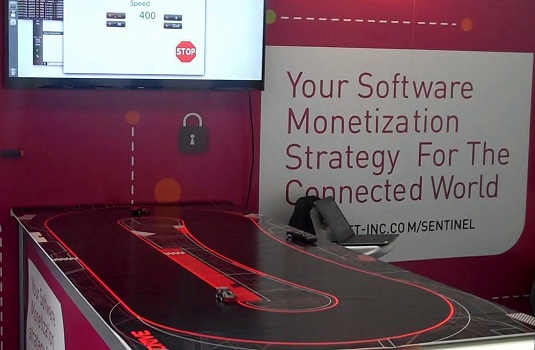 Control and management of software is a booming area, but it needs an easy introduction to the concepts
Control and management of software is a booming area, but it needs an easy introduction to the concepts How do model racing cars help sell the concept of software management and licensing? At the Cloud World Forum in London this week where stand gimmicks were many and various, Gemalto/SafeNet's Regional Director of Software Monetisation, Jamie Longmuir explained the analogy to IT Europa.
“We were thinking about how we could could demonstrate what we do: just talking about an API that switches things on and off is not interesting, The cars are great – they can represent feature-based licensing – and when people see things whizzing round they are interested. We have shown it at a number of events; a laptop controls the cars via Bluetooth and we set the parameters.”
“Once you [the visitor] get it, it demonstrates itself – we have an application which controls four cars, so we can decide how many are connected at the same time – this is a feature - the number of cars - which can be charged for in software as an example, you can set how fast they go, how slow and change which lane they are in – that is three features which can be controlled and we haven't really started on the list.”
“Then we can offer a metered model – you can go round 50 times, or a subscription model – as many goes as you like, but it runs out at the end of the month.”

“It is a very simple way of demonstrating what we do – at a very basic level it is feature-level control. From a vendors' perspective it is great , once I have control I can ask 'how many I have sold?', and to whom have I sold them? Then management: 'how many features are they using?'”
In many ways it is all about getting data back to the vendor so that they can manage their subscription business, and start managing their renewals and their sale forces around how the product is actually being used. “It reveals product management and up-sell opportunities – we may see that a feature is being used far more than the rest. It gives the business supplying software the data the ability to take some intelligence out of it and start managing it.”
The audience at the CWF event is still a mix, he says – four years ago it was all IT directors talking about cloud storage; now it is all about development: “We've just been talking to a visitor about connected apps on a vehicle, so the conversation has definitely changed. People now get this – the idea of control in software. OK, there are still a few that say it is not yet for them, but what is interesting is how we are talking to companies we would never have spoken to in the past. Where once we only dealt with software companies, now we are talking to vendors, to cloud companies who want granular control of their applications, and then perhaps to car companies looking to add controllable features.”
Everyone is a developer now, he says. “On the consumer side everything is app-driven with lots of different models, but the B2B side is vendor-driven and the customer may want different licensing techniques and control over consumption but they [the vendors] are still perhaps a bit behind.” There are a number of reasons for this – a lot of traditional businesses are nervous as they make great revenues out of traditional models of licensing and maintenance. As soon as they move to a subscription model they get worried; sales people are also hard to switch, he explains.
There is a mix, but also a recognition of a need to change how software is packaged - the types of licence models- and this is coming out slowly. “There is definitely a change and the new upstarts are pushing them to change, forcing the dominant behemoths to move. It is relatively cheap to start a cloud business and we are having lots of interesting conversations with these start-ups”
Those not looking at how to control their software and analyse its use have been warned, and it only takes a few model cars to start the discussions with their competitors.